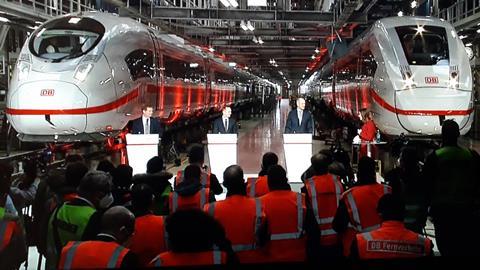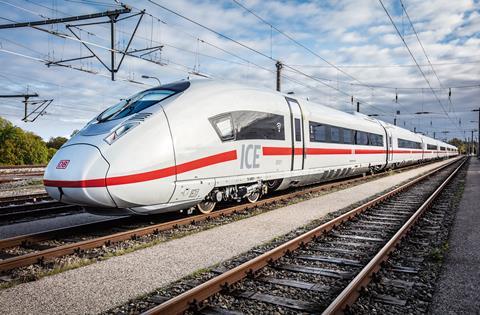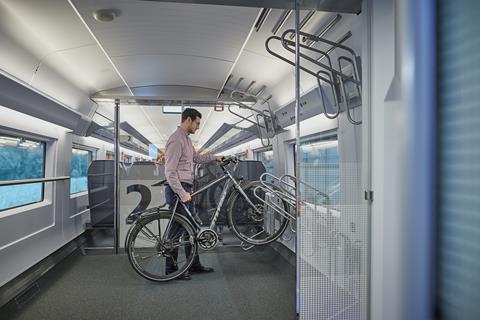
GERMANY: Deutsche Bahn has placed a €1∙5bn firm order for a further 43 Siemens Mobility ICE3neo trainsets, CEO and Chairman of the management board Dr Richard Lutz announced on February 1.
Speaking at an event held in DB’s Berlin-Rummelsburg workshops to unveil the first of 30 ICEneo sets which were ordered in July 2020, Lutz highlighted the partnership with Siemens Mobility that had allowed the train to be assembled in the record time of 12 months.
The original ICE3neo order included an option for 60 more trains.
With testing of the first sets already in hand, DB confirmed that the fleet would enter commercial service from December this year on routes between München and Nordrhein-Westfalen via the Frankfurt – Köln high speed line. All 73 trainsets should be in service by early 2029.

The ICE3neo has 50% of axles motored, giving a power rating of 8 000 kW and a maximum speed of 320 km/h, although the line speed limit in Germany remains at 300 km/h for now. Some of the fleet will be equipped to operate outside Germany ― an earlier version of the ICE3 already operates at up to 320 km/h in France on services to and from Paris via LGV Est-Européen.

The ICE3neo has 439 seats, of which 99 in first class. Space is provided for eight bicycles, and there is a 16-seat restaurant. A family area offers 16 seats plus a five-seat compartment for families with small children. There are 12 entrance doors per side in the eight cars, including one for wheelchair users that features a powered lift to facilitate boarding; two wheelchair spaces are provided.
Enhancements compared with earlier versions of the ICE3 include a novel type of window glass to permit 5G mobile phone reception, redesigned luggage racks and stands for laptops or tablet computers in seat backs as well as power sockets at all seats.

Having arrived at Rummelsburg from Berlin Hauptbahnhof in a special train formed of an ICE4 set that drew up inside the workshop adjacent to the ICE3neo, Lutz said that DB wanted to be ready to deal with the next upsurge in traffic on its high speed routes. The last two years had been ‘an absolute exception’, he said, with reduced traffic levels because of the Covid-19 pandemic.
‘Everything speaks for expanding climate-friendly rail transport ― and that’s why we’re holding to our course for growth and investment’, Lutz continued. ‘With the new ICE, we’re not only providing more capacity in our trains, but are also enhancing the quality and comfort for our passengers.’
Federal Minister for Digital & Transport Dr Volker Wissing said that DB’s ‘new ICE stands for progress on rails ― fast, digital, barrier-free. The 73 new trains with their additional 32 000 seats will make a major contribution to implementing the country’s national Taktfahrplan. This will bring us another step closer to our goal of doubling the number of rail passengers in the next eight years.’
Potential ICE5
President & CEO of Siemens AG Dr Roland Busch noted that DB was putting the trains into service ‘at record speed because we are working on the basis of a long-standing, trusting partnership with DB, and are relying on a proven train platform that we’ve enhanced with numerous innovations for the passengers’.
Busch also referred to his company’s development work for a next-generation high speed train ― potentially an ICE5 ― that could enter service during the 2030s. He added that ‘with our high speed trains we are supporting Deutsche Bahn in realising its vision: transporting more people with maximum comfort, punctuality and better service, and doing so efficiently and with the greatest sustainability.’ He also said that construction of the ICE3neo fleet relied on around 230 sub-suppliers, mainly from Germany.
| Main data for eight-car ICE3neo trainset | |
|---|---|
| Overall length m | 200 |
| Maximum speed km/h | 320 |
| Unladen weight tonnes | 460 |
| Power rating kW | 8 000 |
| Number of bogies | 16 |
| Driven axles | 16 |
| Entrance doors | 12 per side (1 for wheelchairs) |
| Seats | first class 99; second class 340 |
| Wheelchair spaces | 2 |
| Restaurant seats | 16 |
| Cycle spaces | 8 |
| Toilets | 11 (1 wheelchair accessible, 1 for staff) |

















